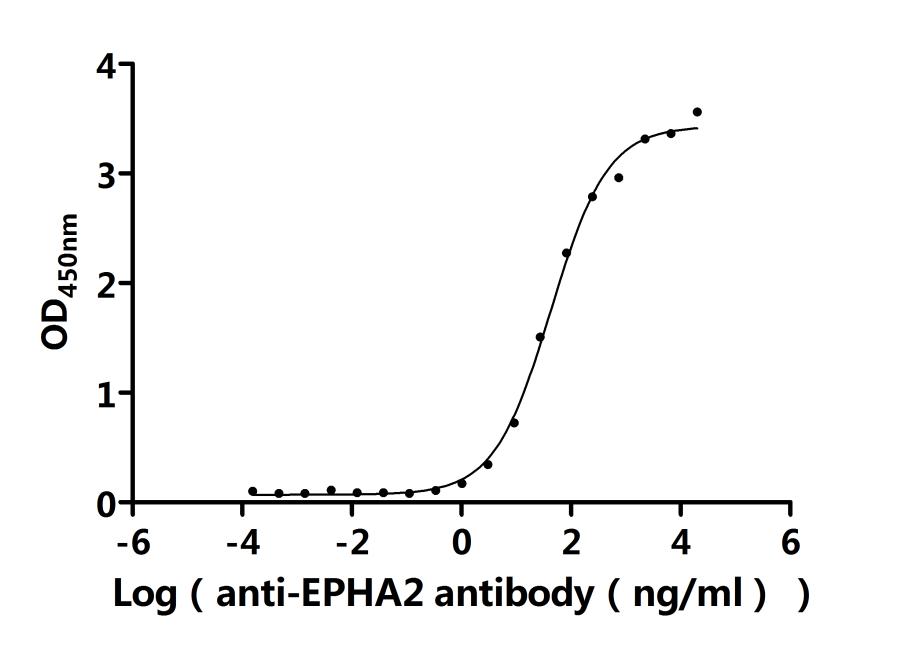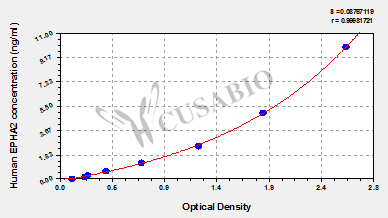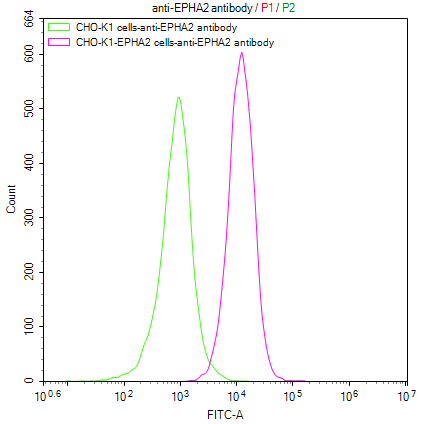[1] Yuki Wakayama, K. Miura, H. Sabe, N. Mochizuki.(2011). EphrinA1-EphA2 Signal Induces Compaction and Polarization of Madin-Darby Canine Kidney Cells by Inactivating Ezrin through Negative Regulation of RhoA.
[2] M. Parri, F. Buricchi, M. Taddei, E. Giannoni, G. Raugei, G. Ramponi, P. Chiarugi.(2005). EphrinA1 Repulsive Response Is Regulated by an EphA2 Tyrosine Phosphatase.
[3] Deo R. Singh, Pranjali P Kanvinde, Christopher King, E. Pasquale, K. Hristova.(2018). The EphA2 receptor is activated through induction of distinct, ligand-dependent oligomeric structures.
[4] Xiaoying Huang, Li Na, Qing Han, Qilun Liu, Ligang Wu.(2025). EPHA2 promotes triple-negative breast cancer progression by suppressing pyroptosis via the AKT/PI3K/mTOR pathway.
[5] G. Martini, C. Cardone, P. Vitiello, V. Belli, S. Napolitano, T. Troiani, D. Ciardiello, C. D. Della Corte, F. Morgillo, N. Matrone, V. Sforza, G. Papaccio, V. Desiderio, M. Paul, V. Moreno‐Viedma, N. Normanno, A. Rachiglio, V. Tirino, E. Maiello, T. Latiano, D. Rizzi, G. Signoriello, M. Sibilia, F. Ciardiello, E. Martinelli.(2019). EPHA2 Is a Predictive Biomarker of Resistance and a Potential Therapeutic Target for Improving Antiepidermal Growth Factor Receptor Therapy in Colorectal Cancer.
[6] Ryan Lingerak, A. Petty, Hong Guo, Hebei Lin, Xiaojun Shi, Soyeon Kim, Bingcheng Wang.(2024). Abstract 1680: Roles of EphA2 receptor signaling in prostate cancer development and progression.
[7] Hee-sung Kim, Y. Won, J. Shim, Hyun Ji Kim, B. Kim, H. Hong.(2019). Role of EphA2-PI3K signaling in vasculogenic mimicry induced by cancer-associated fibroblasts in gastric cancer cells.
[8] J. Jukonen, L. Moyano-Galceran, K. Höpfner, E. Pietilä, Laura Lehtinen, K. Huhtinen, E. Gucciardo, J. Hynninen, S. Hietanen, S. Grénman, P. Ojala, O. Carpén, K. Lehti.(2021). Aggressive and recurrent ovarian cancers upregulate ephrinA5, a non-canonical effector of EphA2 signaling duality.
[9] Hayato Kawachi, Tadaaki Yamada, Yuki Katayama, Takayama Koichi.(2025). Abstract 5532: Combinational targeted therapy effects on EphA2 and KRAS G12C inhibitor against KRAS G12C mutated non-small cell lung cancer cells.
[10] H. E, Lei Zhang, Zhenhua Yang, Long Xu, Tao Wang, Junhong Guo, Lang Xia, Juemin Yu, Heyong Wang, Y. She, Junqi Wu, Yue Zhao, Chang Chen, Deping Zhao.(2024). SNAI1 promotes epithelial-mesenchymal transition and maintains cancer stem cell-like properties in thymic epithelial tumors through the PIK3R2/p-EphA2 Axis.
[11] B. Han, He Zhang, Ruinan Tian, Hui Liu, Zhaosong Wang, Zhiyong Wang, Jianfei Tian, Yanfen Cui, Sixin Ren, Xiaoyan Zuo, Ran Tian, R. Niu, Fei Zhang.(2022). Exosomal EPHA2 derived from highly metastatic breast cancer cells promotes angiogenesis by activating the AMPK signaling pathway through Ephrin A1-EPHA2 forward signaling.
[12] Zicong Gao, Xingxing Han, Yuying Zhu, He Zhang, Ran Tian, Zhiyong Wang, Yanfen Cui, Zhaosong Wang, R. Niu, Fei Zhang.(2020). Drug-resistant cancer cell-derived exosomal EphA2 promotes breast cancer metastasis via the EphA2-Ephrin A1 reverse signaling.
[13] Yunyun Wang, Yong Liu, Guo Li, Z. Su, Shuling Ren, Ping-qing Tan, Xin Zhang, Y. Qiu, Yong-quan Tian.(2014). Ephrin type-A receptor 2 regulates sensitivity to paclitaxel in nasopharyngeal carcinoma via the phosphoinositide 3-kinase/Akt signalling pathway.
[14] Fang Zhang, Yue Zhou, Naru Hamada, Akihiro Tanaka, Satoru Yokoyama, Seiji Yano, Kunio Matsumoto, Hiroyuki Mano, Hiroaki Sakurai.(2025). Stress Response Kinase MK2 Induces Non-canonical Activation of EphA2 in EML4-ALK Lung Cancer Cells.
[15] Ryan Lingerak, Bingcheng Wang.(2023). Abstract B018: Loss of androgen receptor-mediated repression leads to EphA2 overexpression that promotes cellular dedifferentiation and castration resistance of prostate cancer through noncanonical signaling.
[16] Yi-Ping Xiang, T. Xiao, Qi-Guang Li, Shan-Shan Lu, Wei Zhu, Yun-Ya Liu, Jie-Ya Qiu, Z. Song, Wei Huang, Hong Yi, Yao-Yun Tang, Zhi-Qiang Xiao.(2020). Y772 phosphorylation of EphA2 is responsible for EphA2-dependent NPC nasopharyngeal carcinoma growth by Shp2/Erk-1/2 signaling pathway.
[17] J. Hong, M. H. Shin, K. Chung, E. Y. Kim, J. Jung, Y. Kang, Y. S. Kim, S. K. Kim, Joon Chang, M. Park.(2015). EphA2 Receptor Signaling Mediates Inflammatory Responses in Lipopolysaccharide-Induced Lung Injury.
[18] J. Shin, M. Han, Jae Hyung Park, Seung Hyeok Lee, Tae Hoon Kim, Sang Hag Lee.(2023). The EphA1 and EphA2 Signaling Modulates the Epithelial Permeability in Human Sinonasal Epithelial Cells and the Rhinovirus Infection Induces Epithelial Barrier Dysfunction via EphA2 Receptor Signaling.
[19] Sang Hag Lee, Sung Hoon Kang, M. Han, Jinsook Kwak, H. Kim, Tae Hoon Lee, Dabin Lee, Tae Hoon Kim.(2021). The Expression of ephrinA1/ephA2 Receptor Increases in Chronic Rhinosinusitis and ephrinA1/ephA2 Signaling Affects Rhinovirus-Induced Innate Immunity in Human Sinonasal Epithelial Cells.
[20] Elisa Fontana, Babar Bashir, Judy S. Wang, R. Aljumaily, J. Machiels, M. Vieito, G. Falchook, Louise Carter, B. D. de Spéville, A. Greystoke, Sang Wun Kim, Nuria Kotecki, A. Spira, I. M. Candilejo, Bristi Basu, H. Prenen, A. Bessudo, Misako Nagasaka, J. Ahnert, Joo-Hwan Park, M. Teo, J. Rotow, Jie Liu, Assunta De Rienzo, Mengyao Li, Adriana Domingo, Hanna Orr, G. Bennett, Rajiv Sharma, M. McKean.(2023). Abstract LB_A17: Trial in progress: First-in-human phase I dose-escalation study of a novel Bicycle toxin conjugate (BT5528) targeting EphA2 in patients with advanced solid tumors.
[21] Alix Tröster, Michael Diprima, Nathalie Jores, D. Kudlinzki, S. Sreeramulu, S. Gande, Verena Linhard, Damian Ludig, Alexander Schug, K. Saxena, Maria Reinecke, S. Heinzlmeir, M. Leisegang, J. Wollenhaupt, Frank Lennartz, M. Weiss, B. Kuster, G. Tosato, H. Schwalbe.(2023). Optimization of the Lead Compound NVP-BHG712 as Colorectal Cancer Inhibitor.
[22] Yige Fu, Drishti Rathod, Ehab M. Abo-Ali, V. Dukhande, Ketan Patel.(2019). EphA2-Receptor Targeted PEGylated Nanoliposomes for the Treatment of BRAFV600E Mutated Parent- and Vemurafenib-Resistant Melanoma.
[23] Jia-Lin Wang, Yu-ling Liu, Y. Li, Wenbing Dai, Zhao-ming Guo, Zhao-hui Wang, Qiang Zhang.(2012). EphA2 targeted doxorubicin stealth liposomes as a therapy system for choroidal neovascularization in rats.
[24] Xia Li, Dan Li, Rong Ma.(2022). ALW-II-41-27, an EphA2 inhibitor, inhibits proliferation, migration and invasion of cervical cancer cells via inhibition of the RhoA/ROCK pathway.
[25] Julie R. Duffield, Xiaonan Hou, Benjamin W. Wilson, Anjali Prasad, Iman K. McKeon-Makki, A. Huehls, Xinyan Wu, Cristina Correia, Melissa C. Larson, F. Couch, A. Oberg, Scott H. Kaufmann, L. Karnitz, Arun Kanakkanthara.(2025). Abstract A024: A PARP-inhibitor-induced early adaptive survival response is tackled through depletion of FRA1 by brigatinib in high-grade serous ovarian carcinoma.
[26] R. Joseph, S. Dasari, Sujanitha Umamaheswaran, L. Mangala, E. Bayraktar, Cristian Rodríguez-Aguayo, Yutuan Wu, N. Nguyen, Reid T Powell, Mary Sobieski, Yuan Liu, Mark S Kim, Sara Corvigno, Katherine I Foster, Pahul Hanjra, Thanh Chung Vu, Mamur A. Chowdhury, P. Amero, Clifford Stephan, G. Lopez-Berestein, S. Westin, Anil K. Sood.(2024). EphA2- and HDAC-Targeted Combination Therapy in Endometrial Cancer.
[27] Zhongwen Chen, D. Oh, K. Biswas, Cheng-han Yu, R. Zaidel-Bar, J. Groves.(2018). Spatially modulated ephrinA1:EphA2 signaling increases local contractility and global focal adhesion dynamics to promote cell motility.
[28] Ryan J Schuck, Alyssa E Ward, A. Sahoo, Jennifer A. Rybak, Robert J Pyron, Thomas N Trybala, Timothy B Simmons, Joshua A. Baccile, Ioannis Sgouralis, Matthias Buck, Rajan Lamichhane, Francisco N. Barrera.(2025). Cholesterol inhibits assembly and oncogenic activation of the EphA2 receptor.
[29] Matthew L. Scott, Alexandra C. Finney, Wayne W Orr.(2023). Abstract 705: Epha2 Ligand-dependent And Ligand-independent Signaling In Vascular Smooth Muscle Cell Proliferation And Migration.
[30] A. Arabzadeh, Kevin McGregor, Valérie Breton, L. Van Der Kraak, U. Akavia, C. Greenwood, N. Beauchemin.(2017). EphA2 signaling is impacted by carcinoembryonic antigen cell adhesion molecule 1-L expression in colorectal cancer liver metastasis in a cell context-dependent manner.
[31] Angie M. Torres-Adorno, H. Vitrac, Y. Qi, L. Tan, K. Levental, Yang-Yi Fan, Peiying Yang, R. Chapkin, Bedrich L Eckhardt, N. Ueno.(2018). Eicosapentaenoic acid in combination with EPHA2 inhibition shows efficacy in preclinical models of triple-negative breast cancer by disrupting cellular cholesterol efflux.
[32] Dominique V. Parker, Verra M. Ngwa, Jin Chen, Julie A. Rhoades.(2024). Abstract 6866: Investigating the role of Epha2 in breast cancer-mediated myeloid cell expansion and function.
[33] B. Quinn, Si Wang, E. Barile, Swadesh K. Das, L. Emdad, D. Sarkar, S. De, Susan Morvaridi Kharagh, J. Stebbins, S. Pandol, P. Fisher, M. Pellecchia.(2016). Therapy of pancreatic cancer via an EphA2 receptor-targeted delivery of gemcitabine.
[34] Jie-Yu Tang, Yun-Xi Peng, Wei Zhu, Jie-Ya Qiu, Wei Huang, Hong Yi, Shan-Shan Lu, Juan Feng, Zheng-Zheng Yu, Di Wu, Qi Wen, Li Yuan, Jinwu Peng, Zhi-Qiang Xiao.(2025). USP5 Binds and Stabilizes EphA2 to Increase Nasopharyngeal Carcinoma Radioresistance.
[35] Hui-Hua Zhou, Jinfeng Zhao, Xiaolin Yang, Jie Liu, Wei Huang.(2022). Study on the Expression of β-1,3-N-acetylglucosaminyltransferase 3 in Gastric Cancer and the Mechanism Promoting Gastric Cancer Progression Based on the Extraction Method of Nanomagnetic Beads.
[36] Nobuhiko Asakura, Naotoshi Nakamura, Atsushi Muroi, Yosui Nojima, T. Yamashita, S. Kaneko, Kazuki Ikeda, N. Koshikawa, Takashi Suzuki.(2021). Expression of Cancer Stem Cell Markers EpCAM and CD90 Is Correlated with Anti- and Pro-Oncogenic EphA2 Signaling in Hepatocellular Carcinoma.
[37] Zhongwen Chen, D. Oh, K. Biswas, R. Zaidel-Bar, J. Groves.(2021). Probing the effect of clustering on EphA2 receptor signaling efficiency by subcellular control of ligand-receptor mobility.
[38] Carolin Offenhäuser, K. Dave, K. Beckett, Fiona M. Smith, Buddhika A. Jayakody, Leanne T. Cooper, Helen Agyei-Yeboah, Jennifer K. McCarron, Yuchen Li, Kate Bastick, F. Al-Ejeh, Jason K. Cullen, M.
Coulthard, Jeffrey J. Gorman, Andrew W. Boyd, B. Day.(2024). EphA2 regulates vascular permeability and prostate cancer metastasis via modulation of cell junction protein phosphorylation.
[39] N. Koshikawa, Shinya Sato, K. Nio, T. Terashima, M. Ueno, Taro Yamashita.(2024). Abstract A059: Serum EphA2 proteolytic fragment is a potent biomarker for diagnosing a very early stage of ductal pancreatic carcinoma.
[40] L. Moyano-Galceran, E. Pietilä, S. Turunen, Sara Corvigno, E. Hjerpe, Daria R Bulanova, U. Joneborg, Twana Alkasalias, Yuichiro Miki, M. Yashiro, A. Chernenko, J. Jukonen, Madhurendra Singh, Hanna Dahlstrand, J. Carlson, K. Lehti.(2020). Adaptive RSK‐EphA2‐GPRC5A signaling switch triggers chemotherapy resistance in ovarian cancer.
[41] Xinxin Gan, Jiatao Hu, Qingyang Pang, Rui Yan, Y. Bao, Ying Liu, Jiaao Song, Zheng Wang, Weihao Sun, Fuzhao Huang, Chen Cai, Linhui Wang.(2024). LDHA‐mediated M2‐type macrophage polarization via tumor‐derived exosomal EPHA2 promotes renal cell carcinoma progression.
[42] Anan Li, Shijiang Wang, Jiangbo Nie, Shining Xiao, Xinsheng Xie, Yu Zhang, Weilai Tong, Geliang Yao, Ning Liu, Fan Dan, Zhiguo Shu, Jiaming Liu, Zhili Liu, Feng Yang.(2024). USP3 promotes osteosarcoma progression via deubiquitinating EPHA2 and activating the PI3K/AKT signaling pathway.
[43] Dan Tian, Q. Qin, Mingfei Li, Xiaoyu Li, Qing Xu, Qian-zhou Lv.(2021). Homocysteine Impairs Endothelial Cell Barrier Function and Angiogenic Potential via the Progranulin/EphA2 Pathway.
[44] Yidan Wang, Zhenting Zhang, Zhengyan Zhu, P. Wang, Jinjuan Zhang, Hui Liu, Jianyu Li.(2022). The significance of EphA2-regulated Wnt/β-catenin signal pathway in promoting the metastasis of HBV-related hepatocellular carcinoma.
[45] Qiong Wang, Xiangyi Kong, Hongming Song, Li Wang, Lingrui Li, Xiaonan Hou, S. Renuse, M. S. Zahari, Ran Cheng, Md Kamrul Hasan Khan, Jidong Wang, Kiran K. Mangalaparthi, Lin Fang, T. Lotan, B. H. Park, S. Weroha, Huaijun Zhou, Akhilesh Pandey, Xinyan Wu.(2025). Proteomic Analysis of PTEN-Deficient Cells Reveals Src-Mediated Upregulation of EphA2 and Therapeutic Potential of Dual Inhibition.
[46] C. Allocca, A. Cirafici, M. Laukkanen, M. Castellone.(2020). Serine 897 Phosphorylation of EPHA2 Is Involved in Signaling of Oncogenic ERK1/2 Drivers in Thyroid Cancer Cells.










Comments
Leave a Comment